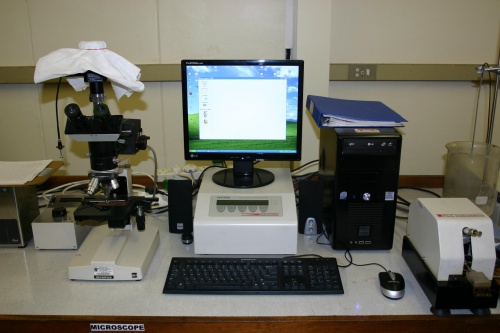Difference between revisions of "T04 High Frequency Reciprocating Rig (HFRR)"
(→2010 (Current)) |
|||
| Line 11: | Line 11: | ||
=== 2010 (Current) === | === 2010 (Current) === | ||
| + | Calibration of the wear scar measurement by Gerhard Marais and Vivian Moller. | ||
| + | The ruler in the eyepiece of the microscope should be used to measure wear scar diameters. At a magnification of IC10 a 100 units on the microscope is equeled to 1mm. | ||
== Documentation == | == Documentation == | ||
Revision as of 09:27, 22 February 2010
The High Frequency Reciprocating Rig (HFRR) was designed by Prof. Hugh Spikes at the Department of Mechanical Engineering, Imperial College, London. Like the SRV, the HFRR also utilizes a ball-on-disk configuration.
The HFRR uses an electromagnetic vibrator to oscillate the top specimen (ball) on the fixed bottom specimen (cylinder), which is held in a small bath. An electrical heater controls the temperature of the test lubricant/fuel in the bath. Both the friction force transmitted between the specimens and the electrical contact resistance (ECR) is measured. Measurement of the wear scar on the top specimen is used to quantify the lubrication of the sample.
The HFRR has been included in the European diesel standard EN 590, which utilizes the ISO12156 (2003) method and also in the American diesel standard ASTM D975 (2004) which utilizes the ASTM D6079 (2005) method.
Contents
Current/Previous Projects
2009
New software and firmware installed by Gerhard Marais.
2010 (Current)
Calibration of the wear scar measurement by Gerhard Marais and Vivian Moller. The ruler in the eyepiece of the microscope should be used to measure wear scar diameters. At a magnification of IC10 a 100 units on the microscope is equeled to 1mm.
Documentation
HFRR Installation & Test Preparation Manuals
Downloadable versions of the manuals provided by PCS Instruments are available.
The HFRR Software Manual is available here
The HFRR Installation and Test Preparation Manual is available here
A procedure for naming tests can be found here
Updating the HFRR firmware and electronics occasionally is essential. Procedures involved in updating the firmware can be found here and procedures involved with the electronics update can be found here The last firmware update was performed in 2009.
The HFRR can also be operated in standalone mode. This operating manual can be found here
Humidity plays a very important role in any HFRR Test. The University of Pretoria's HFRR doesn't have a humidity cabinet, but the operating manual for the new HFRR is available here, and the manual for the older version is available here
Standards
The most updated versions of ASTM D6079 and ISO12156 can be found here. The Tribology Lab uses the ISO method, but the standards are very similar.
Test Procedure
The HFRR test procedure was compiled by Rucu Maree in January 2010.
